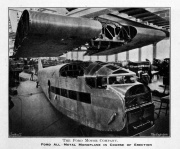This refers to Ford in the UK.
See also
Ford produced Cars and Lorries in the UK from 1911 and was the manufacturing and sales arm of the Ford Motor Company, USA for the UK. The firm both sold and manufactured cars and commercial vehicles for sale in the United Kingdom and other countries.
1903 The first Ford cars, three Model As, were imported into the UK.
1909 the Ford Motor Company (England) Ltd. was established with an office in 55 Shaftesbury Avenue, London under the chairmanship of Percival Perry.
1910 The first dealership opened in Southampton.
1911 An assembly plant was opened in an old Tram factory in Trafford Park, Manchester employing 60 people to make the Model T; the company was re-registered as Henry Ford & Son, Ltd. This was the first Ford factory outside North America.
At first the cars were assembled from imported chassis and mechanical parts with bodies sourced locally, but in 1914 Britain's first moving assembly line for car production started with 21 cars an hour being built.
Six thousand cars were produced in 1913 and the Model T became the country's biggest selling car with 30% of the market.
After the First World War, the Trafford Park plant was extended, and in 1919, 41% of British registered cars were Fords.
In 1917, a plant opened in Cork, Ireland initially for tractor manufacture but from 1921 cars as well were built. This factory was the first to be purpose built by Ford in Europe. It closed in 1984.
1923 Although the Manchester plant was served by the Manchester Ship Canal, Ford decided that access to a deep water port was required and in 1923 a new site was chosen by the River Thames at Dagenham, East London. Construction started in 1929, and in October 1931, Britain and Europe's largest car plant opened producing the Model AA truck and Model A car. The company also at the same time changed its name to the Ford Motor Co. Ltd. This was at the height of the Depression and the Model A was too expensive to tax and run in Britain and very few were sold, only five in the first three months. 150,000 Model Ts were built at Trafford Park.
1924 94 percent of the parts used in the Model T came from British suppliers but the horsepower tax hit sales.
1933 (Aircraft Department). Assembling, testing, modifying and overhauling Ford aeroplanes for England and the Continent. Works: Ford Aerodrome, Ford, Sussex. Head Office: 88 Regent Street, London W.1.[1]
1933 A smaller car was urgently needed and this came in 1933 with the 933 cc Model Y, a car much more suited to the market and becoming in 1935 Britain's first £100 car.
Between 1932 and 1937 over 157,000 were made at Dagenham and Cork and at its peak it captured 41% of its market sector.
WWII: During the Second World War, the Dagenham plant turned out 360,000 vehicles and a new factory in Urmston, Manchester made 34,000 Rolls-Royce Merlin engines.
After World War Two, civilian production resumed and Dagenham made 115,000 vehicles in 1946 and factories in Walthamstow in Essex (later London) and Langley in Buckinghamshire (later Berkshire) were acquired.
1953 Briggs Motor Bodies was purchased, giving the company more control of its supplies and at the same time acquiring further plants at Doncaster, Southampton, Croydon and Romford. By 1953, Ford of Britain directly employed 40,000 people.
1961 Manufacturers of Ford cars, Fordson tractors, Thames and Thames Trader commercial vehicles. Main plant at Dagenham, with one blast furnace, 14 and 18 in. rolling mills, 48 coke ovens complete with by-products plant and two foundries. 56,000 employees. [2]
In 1962, Ford opened a factory at Halewood near Liverpool to make the Anglia. .
Another new factory opened at Basildon in 1964 to make tractors, and in 1965, a further plant was acquired at Crymlyn Burrows, Swansea to make chassis components and axles.
Ford transferred all the tractor production from its Antwerp plant to Basildon, making the Essex factory the sole producer of Ford tractors in Europe at the time.[3]
2000 Halewood closed as a Ford plant when the last Escort came off the production line in 2000 and it was then converted to make the Jaguar X-Type in 2001
2015 Employ 199,000 persons worldwide with 53,000 in Europe (16 plants).[4]
2015 UK plants and employees -[5]
- Bridgend (Engines) - 2,137 persons
- Dagenham (Engines) - 1,835 persons
- Dunton (Technical centre) - 3,500 persons [6]
- Halewood (Transmissions) - 715 persons
Total: approx 8,500 persons
See Also
Sources of Information
- ↑ 1933 Who's Who in British Aviation
- ↑ 1961 Dun and Bradstreet KBE
- ↑ The Engineer 1981/04/09
- ↑ 2015 Annual report
- ↑ Ford Corporate web site
- ↑ Basildon Council
- [1] Wikipedia – Ford of Britain
- British Lorries 1900-1992 by S. W. Stevens-Stratten. Pub. Ian Allen Publishing
- British Motor Cars 1950/51
















































